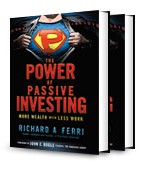

 Today we take it for granted that virtually all mutual funds and stock pickers are trying to earn higher returns than the overall market — or at least earn the same returns with lower risk. But Rick Ferri’s outstanding new book, The Power of Passive Investing
Today we take it for granted that virtually all mutual funds and stock pickers are trying to earn higher returns than the overall market — or at least earn the same returns with lower risk. But Rick Ferri’s outstanding new book, The Power of Passive Investing (Wiley, 2010), reveals that beating the market hasn’t always been the goal of long-term investors.
(Wiley, 2010), reveals that beating the market hasn’t always been the goal of long-term investors.
When mutual funds first appeared in the 1920s, Ferri explains, there wasn’t even a generally accepted benchmark for the market as a whole: the Dow Jones Industrial Average had been around since 1896, but it contained just 12 companies (increased to 30 in 1928), was weighted by price, and has never been a good measure of the stock market as a whole.
The original goal of mutual funds, then, was to simply give small investors an opportunity to own a portfolio of stocks—something that was difficult and prohibitively expensive to do at that time. “Their mission,” Ferri writes, “was to select superior securities that paid reasonable dividends, to secure profits without to speculation, and to conserve principal.”
Ben Graham: The first indexer?
Although Ferri doesn’t write about this specifically, you can make the same observation about stock pickers. Benjamin Graham’s The Intelligent Investor, first published in 1949, is still the bible of value investors. The book filled a genuine need at that time: if you wanted to be in the market, you had to know how to pick individual stocks. (Mutual funds were still in their infancy, and few investors had confidence in them after the Depression.) But Graham’s original readers were not necessarily trying to beat the market—they were simply trying to select prudent, profitable companies rather than engaging in speculation.
In fact, in a 1946 lecture, Graham remarked: “There is nothing to prevent the investor from actually buying the Dow Jones Industrial Average, though I never heard of anybody doing it. It seems to me it would make a great deal of sense if he did.” That might be the earliest endorsement of index investing on record.
Some 30 years later, shortly before his death in 1976, Graham did an interview with the Financial Analysts Journal in which he acknowledged that the average money manager could not beat the market: “That would mean the stock market experts as a whole could beat themselves — a logical contradiction.” For that reason, he said, investors should be content with the returns of the index.
How index funds changed the game
Beginning in the 1960s, Ferri writes, academics began doing research to see if they could identify skilled money managers. To their surprise, they found this was impossible: once they adjusted for risk, the academics could not separate skill from luck. Their data also determined that most active managers underperformed the market, and that investors would have been better off if they had just invested the S&P 500, which appeared in 1957. The money managers didn’t necessarily disagree with those findings, but they were quick to point out that “you can’t buy an index.”
In 1976, all that changed. That was the year that Vanguard created the first S&P 500 index fund for retail investors. Now, for all practical purposes, anyone could get the same return as the overall market (or at least the large-cap US market), and they could do so at very low cost. Predictably, the very idea was ridiculed at first — “Who would want average returns?” — but as it caught on, money managers were forced to justify their very existence.
Ferri points out that this represented “a titanic shift in industry ideology. For the first time, fund companies took the stand that it wasn’t enough to simply offer diversification through a pooled basket of securities that investors couldn’t achieve on their own at the same cost. The new mission was to beat the market.”
As a group, they have been failing in this mission for almost 90 years. In my next post, I’ll look at Ferri’s take on the probability that actively managed funds will outperform index funds over periods of five years and longer.













